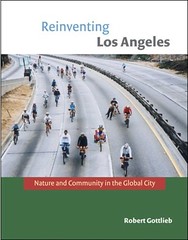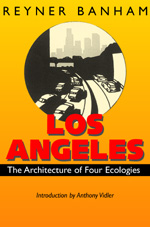Greening LA

Posted April 1, 2008 at 3:18AM
I'm so looking forward to reading Occidental College prof Robert Gottlieb's latest book, Reinventing Los Angeles: Nature and Community in the Global City (MIT Press, 2007).  It promises as much cultural as environmental enlightenment, examining, as the publisher puts it, "how imaginative and innovative social movements have coalesced around the issues of water development, cars and freeways, and land use, to create a more livable and sustainable city." How can one make sense of a place that is such an icon of all things unnatural? The reports are that Gottlieb rises to the challenge.
It promises as much cultural as environmental enlightenment, examining, as the publisher puts it, "how imaginative and innovative social movements have coalesced around the issues of water development, cars and freeways, and land use, to create a more livable and sustainable city." How can one make sense of a place that is such an icon of all things unnatural? The reports are that Gottlieb rises to the challenge.
Personally, I fell in love with LA the moment I stepped foot there, first as a 10-year-old whose parents allowed me to go alone on an overnight flight to meet my older brother, who was already married and living there. Freeways, Disneyland, the ocean, movie sets, what's not to like for a young kid from North Carolina?
Years later, I started going fairly regularly on work trips and learned a lot more about what the place held in store for an adult, especially one with a keen interest in music. I had a couple of good mentors showing me where to hang out and such and, man, the weather was always incredible.
I have a feeling that Gottlieb's book contains some adult doses of reality to go with those idealistic notions, and so it should. But there is still a bit of the dreamer inhabiting his chosen narrative, about citizens coming together to reimagine the LA river as an urban natural resource, to close the Pasadena Freeway for a day of cycling, to make useful social context of the powerful forces of immigration and globalization that are profoundly shaping the US's second-largest city. Those, say the reviewers, are the three large themes that the author uses to tell his story.
 Reading about someone making thematic sense of the superficially disjointed metropolis puts me in mind of a much older book that is one of my all-time favorites, Los Angeles: the Architecture of Four Ecologies, by Reyner Banham (UC Press, 2001 edition). Originally published in 1971, Banham's work and I found each other before I had any interest in the environment or cities in a professional or even aspirational sense, but I was already a young architecture buff and wannabe-Angeleno. The book looks at the LA of an earlier generation than that of Gottlieb, and it is the work of someone more observer than reformer. But what a gifted observer:
Reading about someone making thematic sense of the superficially disjointed metropolis puts me in mind of a much older book that is one of my all-time favorites, Los Angeles: the Architecture of Four Ecologies, by Reyner Banham (UC Press, 2001 edition). Originally published in 1971, Banham's work and I found each other before I had any interest in the environment or cities in a professional or even aspirational sense, but I was already a young architecture buff and wannabe-Angeleno. The book looks at the LA of an earlier generation than that of Gottlieb, and it is the work of someone more observer than reformer. But what a gifted observer:
"Los Angeles looks naturally to the Sunset, which can be stunningly handsome, and named one of its great boulevards after that favourite evening view. But if the eye follows the sun, westward migration cannot. The Pacific beaches are where young men stop going West, where the great waves of agrarian migration from Europe and the Middle West broke in a surf of fulfilled and frustrated hopes. The strength and nature of this westward flow need to be understood; it underlies the differences between Los Angeles and its sister-metropolis to the north . . ."
Banham's themes are the beach, the freeways, the flatlands, and the foothills, and how each shaped the built environment and culture of LA. As one reviewer put it, "Banham discovered new ways of seeing and writing about cities . . . His was an architecture in place; he wrote a new kind of urban history." And he also made reading about it a heck of a lot of fun.
Highly recommended. And, as you open the book, cue up your iPod to "The Promised Land" by the immortal Chuck Berry:
Los Angeles give me Norfolk, Virginia,
TIdewater 4-10-0-9Tell the folks back home this is the Promised Land callin'
And the poor boy's on the line
If you can keep your foot still while listening to that song, you really need some time off. Till next time.